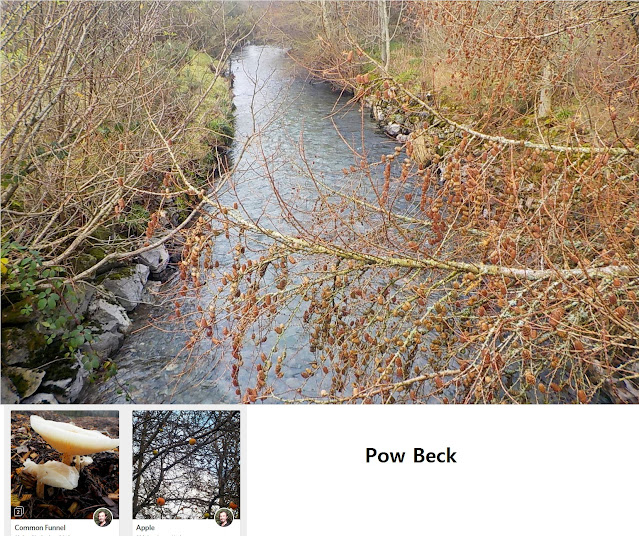Just to the north of Keswick, beyond the dual carriageway of the A66, lies a remnant of the old coach road from Penrith to Cockermouth. This is where we begin our journey, exploring the area between Derwent Water and Bassenthwaite Lake. It's a bit damp today, and Skiddaw is wearing the clouds like a feather boa, but it's not raining. If you're wondering what that expanse of brown is, in the middle distance, it's an osier plantation. But we'll come to that later... unfortunately.
The old coach road crosses Pow Beck, one of many becks that feed Bassenthwaite Lake, along with the river Derwent, which flows in from Derwent Water. Next to this, there used to be a very good campsite, so Ishbel tells me (she, being a repository of all knowledge on Cumbrian campsites). Sadly, it has now been abandoned, and is overgrown with seeding dock. A lonely apple tree sits in the centre, and on a pile of wood chippings, what look to be Common Funnel mushrooms have found the perfect home.
Heading up a little lane, the sheep grazed fields to our left provide perfect conditions for rabblts, whilst the long, tussocky grass to our right is the preferred feeding grounds for pheasants. I have recently acquired a six volume set of Cassells Natural History, published in 1881, and it has this to say on the feeding habits of the common pheasant:
[the pheasant] seeks its food, which consists of grain, seeds, green shoots, and insects, among hedge-bottoms and thickets with long grass and tolerably dense undergrowth; it also affects damp ground and osier beds.
Note the words 'damp ground' and 'osier beds'. The footpath leads us into both. They don't shy away from saying what they mean up here in Cumbria. If your house nestles on the edge of a bog, you call it Bog House (and for those of you who's first language is not English, this is also a euphamism for the lavatory). We emerged from the osier bed with sea boots and a two-toned dog.
Crossing a field, we managed to dislodge about half of the accumulated mud, and emerged onto the old Penrith to Cockermouth railway line. A magnificent Birch Polypore was growing at the base of a silver birch, and nearby, in a discarded plastic bucket, a small amount of rainwater had proved sufficient for some Winter Midges to breed. These are Chironomids, or non-biting midges.
In other news, for those of you who are local, CADS are putting on the hilariously funny
'The Farndale Avenue Townswomen Guild Drama Society's production of A Christmas Carol'
I can say this because I'm not in it, merely making sure you can see it by operating the lights. This Saturday (10th) 2pm and Sunday (11th) 7pm. Buy your tickets here.
The reason that I have recently acquired a six volume set of Cassells Natural History, published in 1881, is because I have opened up an antiquarian book department in my online shop. A geographical theme this week, but the Cassells will be up for sale later – if I can bear to part with it. Pop in and take a look: Steve's Vintage Collectables – Beautiful Books.
And talking of books...
 |
Beetles and Butterflies; spiders and scorpions; woodlice and worms. How do you tell them all apart? To say nothing of crane flies, dragonflies, bee flies and yet more butterflies. Are they all flies? If not, why call them so? If you're fascinated but confused by the beautiful world of the very small, then this is the book for you.
82 pages of information on all aspects of the world of minibeasts, with over 100 photographs and illustrations, this book will help you track down and identify any arthropod, in its adult or juvenile state, anywhere in the world.
See all of my books at author.to/SteveDaniels |
All the best,
Steve
Follow me on Steve's Nature Plus
and also on Twitter Steve's Nature, Facebook Steve Daniels Naturalists, and Instagram












What a wonderful place, even on a damp day.
ReplyDelete